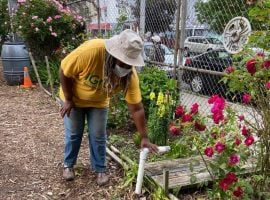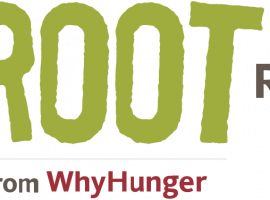
On a triangle of land in the South Bronx, gardeners at the urban farm La Finca Del Sur are growing strawberries through the concrete. The farm sits at the middle of an urban jungle – Metro North and Amtrak roars on one side of the garden and a highway ramp on the other, while the enormous plane trees that grow on the garden’s eastern fence have roots that reach toward the tunnel of the 4/5 subway line. But inside the garden, peace reigns. Bees hum, sunflowers nod and grapes dangle on the vine. And the farmers are gardening.
Last week, on July 30th, Suzanne Babb, one of the community garden members of La Finca Del Sur and WhyHunger’s Community Partnerships Manager, invited WhyHunger staff members and interns to the farm, for a day of volunteer gardening.
Suzanne explained that the garden was founded in 2009, with the purpose of providing local women of color a place to grow fresh and healthy food and develop leadership– and with the long term goal of the green space improving neighborhood health through nutrition, education, economic empowerment and social justice. Now there are 15 to 20 farmer members participating in La Finca Del Sur. The farm is has no paid staff, and is struggling to find new funding, so along with running his or her individual plot, each farmer does at least six hours a month of gardening in the communal garden. There, produce and flowers are grown to sell at the South Bronx Farmer’s Market held a few blocks away. Suzanne told us that one local man comes to the market regularly with his son to buy fresh flowers to take home to his wife. Along with the flowers, Suzanne said the farm’s fresh herbs, such as papalo, epazote and cilantro, have been particularly well received as produce that actually reflects the preferences of the South Bronx community, which Suzanne described as a neighborhood with a strong culture of cooking, but limited options for buying or growing healthy food.
Suzanne and Freddy Gonzalez, another La Finca Del Sur member and longtime Bronx resident, showed us around the garden. A sudden burst of heavy summer rain had left the garden glistening and fragrant. Two and a half acres of land doesn’t sound like much to support all the members and the community, but space at La Finca Del Sur has been efficiently organized. The farmers’ efforts have been rewarded with a beautiful abundance – tightly curled cabbages, sweet-smelling basil, garlic, collard greens, tomatoes, tiny red strawberries, Swiss chard, potatoes and beets in tall pots. Each bed of vegetables is brightened by vibrant orange marigolds, which Suzanne explained help attract the bees.
Suzanne and Freddy were full of knowledge of purposeful planting – such as the large lavender bush, which they explained is not only pretty but acts as a natural bug repellant. The farmers grow their vegetables in raised beds and pots, which they keep free of pesticides and Miracle Gro. The soil, bought from upstate New York, is used in raised vegetable beds because most of New York City soil is damaged by lead and other contamination. But although they don’t grow their produce from it right now, the gardeners are working to heal the dirt beneath their feet, planting rows of cheerful sunflowers, which draw contamination out from the soil. The farmers cultivate their garden from the ground up, regenerating the soil with composting, and growing their plants mostly from seeds (mostly donated), which they raise in a green house.
Once our tour was finished, the WhyHunger team joined Suzanne in the main mission of the day – weeding. It’s one of the strange truths of gardening that weeding is almost as good for the gardener as it is for the plant – as I turned the earth over, and carefully plucked invaders out from around the cabbages, I felt my mind become clear and focused. Maybe that’s because weeding combines seeming contradictions – it’s about pruning, plucking and ‘cleaning up’, but it’s also about getting your hands dirty. And while you embrace ruthless decision-making in which weeds are recognized and uprooted, you also offer gentleness and protection, caring for the plants that nourish us. Every time I looked up, my fellow-gardeners were frowning with focus, but simultaneously smiling with the satisfaction of tugging out another stubborn weed.
It’s one of the strange truths of gardening that weeding is almost as good for the gardener as it is for the plant
I grew up in Aotearoa New Zealand, a country about the size of Great Britain, but with a total population that is half that of New York City. While our people are not especially affluent, New Zealanders are hugely wealthy in terms of their access to the land. Even in the biggest city centers, apartment living is still a rarity. Almost everybody lives in a house, and that house usually comes with a bit of land – maybe a small front lawn, or maybe a sprawling backyard garden. With beaches all around, many people spend most of their time barefoot – a condition which applies to pavement and supermarkets, as well as the sand. Walking barefoot, cultivating a garden, swimming in rivers you know well– these experiences teach you that access to land isn’t a privilege, but a right, a vital part of living on a green planet. But after a year of living in New York City, to be able to garden at La Finca Del Sur felt to me like the height of luxury. I felt so lucky to have access, for a day, to growing things. But a luxury is exactly what access to the land shouldn’t be. While the paradigm of the New Zealand back yard won’t last forever, and certainly is no longer applicable to New York, the peaceful abundance of La Finca Del Sur offers an inspiring alternative. If there are more urban farms like it in the City, more communities will have access to gardening – the oldest means of feeding yourself, your family and your community, and a way to understand the land we live on.
Evangeline Graham is WhyHunger’s current Editorial Intern. An artist and writer living in Brooklyn, she originally hails from Aotearoa New Zealand.





